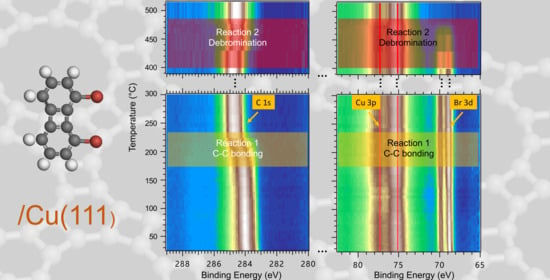Spectroscopic Evidence of New Low-Dimensional Planar Carbon Allotropes Based on Biphenylene via On-Surface Ullmann Coupling
Abstract
:Supplementary Materials
Author Contributions
Funding
Data Availability Statement
Acknowledgments
Conflicts of Interest
References
- Lüder, J.; Puglia, C.; Ottosson, H.; Eriksson, O.; Sanyal, B.; Brena, B. Many-body effects and excitonic features in 2D biphenylene carbon. J. Chem. Phys. 2016, 144, 024702. [Google Scholar] [CrossRef]
- Hudspeth, M.A.; Whitman, B.W.; Barone, V.; Peralta, J.E. Electronic Properties of the Biphenylene Sheet and Its One-Dimensional Derivatives. ACS Nano 2010, 4, 4565–4570. [Google Scholar] [CrossRef]
- Ferguson, D.; Searles, D.J.; Hankel, M. Biphenylene and Phagraphene as Lithium Ion Battery Anode Materials. ACS Appl. Mater. Interfaces 2017, 9, 20577–20584. [Google Scholar] [CrossRef]
- Brunetto, G.; Autreto, P.A.S.; Machado, L.D.; Santos, B.I.; dos Santos, R.P.B.; Galvão, D.S. Nonzero Gap Two-Dimensional Carbon Allotrope from Porous Graphene. J. Phys. Chem. C 2012, 116, 12810–12813. [Google Scholar] [CrossRef] [Green Version]
- De La Pierre, M.; Karamanis, P.; Baima, J.; Orlando, R.; Pouchan, C.; Dovesi, R. Ab Initio Periodic Simulation of the Spectroscopic and Optical Properties of Novel Porous Graphene Phases. J. Phys. Chem. C 2013, 117, 2222–2229. [Google Scholar] [CrossRef]
- Baughman, R.H.; Eckhardt, H.; Kertesz, M. Structure-property predictions for new planar forms of carbon: Layered phases containing sp2 and sp atoms. J. Chem. Phys. 1987, 87, 6687–6699. [Google Scholar] [CrossRef]
- Denis, P.A.; Iribarne, F. Hydrogen storage in doped biphenylene based sheets. Comput. Theor. Chem. 2015, 1062, 30–35. [Google Scholar] [CrossRef]
- Fan, Q.; Yan, L.; Tripp, M.W.; Krejčí, O.; Dimosthenous, S.; Kachel, S.R.; Chen, M.; Foster, A.S.; Koert, U.; Liljeroth, P.; et al. Biphenylene network: A nonbenzenoid carbon allotrope. Science 2021, 372, 852–856. [Google Scholar] [CrossRef] [PubMed]
- Tyutyulkov, N.; Dietz, F.; Müllen, K.; Baumgarten, M. Structure and energy spectra of a two-dimensional dielectric carbon allotrope. Chem. Phys. Lett. 1997, 272, 111–114. [Google Scholar] [CrossRef]
- Karaush, N.N.; Baryshnikov, G.V.; Minaev, B.F. DFT characterization of a new possible graphene allotrope. Chem. Phys. Lett. 2014, 612, 229–233. [Google Scholar] [CrossRef]
- Hussain, T.; Hankel, M.; Searles, D.J. Graphenylene Monolayers Doped with Alkali or Alkaline Earth Metals: Promising Materials for Clean Energy Storage. J. Phys. Chem. C 2017, 121, 14393–14400. [Google Scholar] [CrossRef]
- Song, Q.; Wang, B.; Deng, K.; Feng, X.; Wagner, M.; Gale, J.D.; Müllen, K.; Zhi, L. Graphenylene, a unique two-dimensional carbon network with nondelocalized cyclohexatriene units. J. Mater. Chem. C 2013, 1, 38–41. [Google Scholar] [CrossRef] [Green Version]
- Costantini, R.; Stredansky, M.; Cvetko, D.; Kladnik, G.; Verdini, A.; Sigalotti, P.; Cilento, F.; Salvador, F.; De Luisa, A.; Benedetti, D.; et al. ANCHOR-SUNDYN: A novel endstation for time resolved spectroscopy at the ALOISA beamline. J. Electron Spectrosc. Relat. Phenom. 2018, 229, 7–12. [Google Scholar] [CrossRef]
- Gutzler, R.; Cardenas, L.; Lipton-Duffin, J.; El Garah, M.; Dinca, L.E.; Szakacs, C.E.; Fu, C.; Gallagher, M.; Vondráček, M.; Rybachuk, M.; et al. Ullmann-type coupling of brominated tetrathienoanthracene on copper and silver. Nanoscale 2014, 6, 2660–2668. [Google Scholar] [CrossRef] [Green Version]
- Galeotti, G.; Di Giovannantonio, M.; Lipton-Duffin, J.; Ebrahimi, M.; Tebi, S.; Verdini, A.; Floreano, L.; Fagot-Revurat, Y.; Perepichka, D.F.; Rosei, F.; et al. The role of halogens in on-surface Ullmann polymerization. Faraday Discuss. 2017, 204, 453–469. [Google Scholar] [CrossRef] [PubMed]
- Galeotti, G.; Di Giovannantonio, M.; Cupo, A.; Xing, S.; Lipton-Duffin, J.; Ebrahimi, M.; Vasseur, G.; Kierren, B.; Fagot-Revurat, Y.; Tristant, D.; et al. An unexpected organometallic intermediate in surface-confined Ullmann coupling. Nanoscale 2019, 11, 7682–7689. [Google Scholar] [CrossRef] [PubMed]
- Dahal, A.; Batzill, M. Graphene–nickel interfaces: A review. Nanoscale 2014, 6, 2548. [Google Scholar] [CrossRef] [PubMed]
- Totani, R.; Grazioli, C.; Zhang, T.; Bidermane, I.; Luder, J.; de Simone, M.; Coreno, M.; Brena, B.; Lozzi, L.; Puglia, C. Electronic structure investigation of biphenylene films. J. Chem. Phys. 2017, 146, 054705. [Google Scholar] [CrossRef]
- Reichert, J.; Schiffrin, A.; Auwärter, W.; Weber-Bargioni, A.; Marschall, M.; Dell’Angela, M.; Cvetko, D.; Bavdek, G.; Cossaro, A.; Morgante, A.; et al. l-Tyrosine on Ag(111): Universality of the Amino Acid 2D Zwitterionic Bonding Scheme? ACS Nano 2010, 4, 1218–1226. [Google Scholar] [CrossRef]
- Cossaro, A.; Puppin, M.; Cvetko, D.; Kladnik, G.; Verdini, A.; Coreno, M.; de Simone, M.; Floreano, L.; Morgante, A. Tailoring SAM-on-SAM Formation. J. Phys. Chem. Lett. 2011, 2, 3124–3129. [Google Scholar] [CrossRef]
- Stredansky, M.; Sala, A.; Fontanot, T.; Costantini, R.; Africh, C.; Comelli, G.; Floreano, L.; Morgante, A.; Cossaro, A. On-surface synthesis of a 2D boroxine framework: A route to a novel 2D material? Chem. Commun. 2018, 54, 3971–3973. [Google Scholar] [CrossRef] [PubMed]




Publisher’s Note: MDPI stays neutral with regard to jurisdictional claims in published maps and institutional affiliations. |
© 2021 by the authors. Licensee MDPI, Basel, Switzerland. This article is an open access article distributed under the terms and conditions of the Creative Commons Attribution (CC BY) license (https://creativecommons.org/licenses/by/4.0/).
Share and Cite
Zhang, T.; Grazioli, C.; Yang, H.; Jiang, K.; Brumboiu, I.E.; Jia, L.; Liu, L.; Puglia, C.; Zhuang, X.; Wang, Y. Spectroscopic Evidence of New Low-Dimensional Planar Carbon Allotropes Based on Biphenylene via On-Surface Ullmann Coupling. Chemistry 2021, 3, 1057-1062. https://0-doi-org.brum.beds.ac.uk/10.3390/chemistry3030076
Zhang T, Grazioli C, Yang H, Jiang K, Brumboiu IE, Jia L, Liu L, Puglia C, Zhuang X, Wang Y. Spectroscopic Evidence of New Low-Dimensional Planar Carbon Allotropes Based on Biphenylene via On-Surface Ullmann Coupling. Chemistry. 2021; 3(3):1057-1062. https://0-doi-org.brum.beds.ac.uk/10.3390/chemistry3030076
Chicago/Turabian StyleZhang, Teng, Cesare Grazioli, Huixia Yang, Kaiyue Jiang, Iulia Emilia Brumboiu, Liangguang Jia, Liwei Liu, Carla Puglia, Xiaodong Zhuang, and Yeliang Wang. 2021. "Spectroscopic Evidence of New Low-Dimensional Planar Carbon Allotropes Based on Biphenylene via On-Surface Ullmann Coupling" Chemistry 3, no. 3: 1057-1062. https://0-doi-org.brum.beds.ac.uk/10.3390/chemistry3030076







